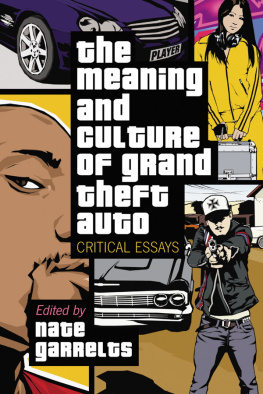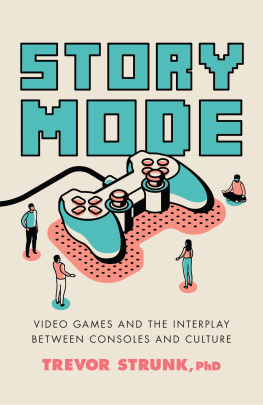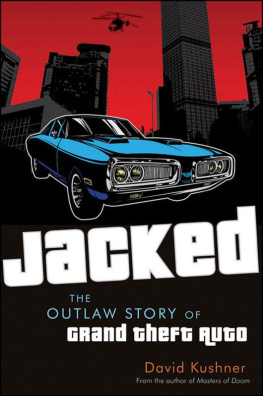
Table of Contents
Also by Nate Garrelts
Digital Gameplay: Essays on the Nexus of Game and Gamer (McFarland, 2005)
LIBRARY OF CONGRESS CATALOGUING-IN-PUBLICATION DATA
The meaning and culture of Grand theft auto : critical essays / edited by Nate Garrelts.
p. cm.
Includes bibliographical references and index.
ISBN-13: 978-0-7864-2822-9
1. Grant Theft Auto gamesSocial aspects. 2. Video gamesSocial aspects. I. Garrelts, Nate.
GV1469.35.G738M43 2006
794.8dc22 2006023510
British Library cataloguing data are available
2006 Nate Garrelts. All rights reserved
No part of this book may be reproduced or transmitted in any form or by any means, electronic or mechanical, including photocopying or recording, or by any information storage and retrieval system, without permission in writing from the publisher.
Cover art 2006 Digital Vision
McFarland & Company, Inc., Publishers
Box 611, Jefferson, North Carolina 28640
www.mcfarlandpub.com
For Beth and Winton
An Introduction to Grand Theft Auto Studies
NATE GARRELTS
Pogo is just what the video game industry was looking for. A cutesy character in a platform puzzler. 10/10.
Joy-Stuck.net (qtd. on pogothemonkey.com)
The public discourse on digital games is a tangle of political rhetoric, reactionary responses, and game journalism; it is as passionate as it is negligent. But the public discourse is not the only discourse on digital games; academics have been studying this new medium since its invention. With the explosion of academic interest in digital games at the beginning of the twenty-first century, academic discourse on games has just now begun spilling into the public discourse with an ever-increasing number of books, journals, interviews, and testimonies centered on academic inquiries into the medium. Though there are some exceptions, the academic conversation is informed and critical but not often accessible to the general public or even other academicsdigital game studies span several disciplines and draw upon diverse sets of theories, each with a complicated vocabulary. This collection of essays was compiled to help academic game studies bridge the boundaries of academia to speak directly to the gaming public and other interested partiesincluding politicians, journalists, review boards, and parents. To this end, the essays in this collection study the immensely popular and controversial Grand Theft Auto series, with a particular emphasis on Grand Theft Auto III (GTA3), Grand Theft Auto: Vice City (GTA:VC), and Grand Theft Auto: San Andreas (GTA:SA).
Part One is aptly titled Grand Theft Auto v. The Power-Go-Round. Obviously, the games in this series are significant not just because they are popular among players, but because they have also given rise to a host of fears, lawsuits, legislative proposals, and other public reactions. The series has entered culture in such a way that it is embraced by adult players because it empowers them in various ways, and, at the same time, the games have become an icon for child endangerment and are continually used by politically minded individuals and organizations to further their agendas.
The first few essays in this part sketch out a scenario in which game developers like Rockstar are trying to make adult oriented games and at the same time are faced with new forms of censorship. The essays talk about the depictions of race and violence in Grand Theft Auto games, the pleasure of the carnivalistic gameplay, and the significance of satire in the series. At the end of this part, it is argued that the way we think and talk about digital games was fundamentally altered following the release of Grand Theft Auto III.
Part Two, A Grand Theft Auto Way of Life, approaches the games as they might be studied absent the controversy; the essays in this part study how players meaningfully and purposefully play Grand Theft Auto games. The authors in this part reflect on the elements of daily life that are represented, including the connection between gamespace and real space, and the many ways that players mediate the symbols in a game with their minds, computers, and controllers.
Aside from strategy guides and other popular texts, this is the first academic book to focus explicitly on a single game series, and there are several advantages to this approach. Because of the popularity (and notoriety) of Grand Theft Auto games, readers have ample incentive to wade through some of the theoretical complexity. Additionally, because of profound overlaps in game content, the analysis of one game in the series is often easily transferred to several other games in the series without further qualification.
In effect, this means that readers need knowledge of (or easy access to) only one of the primary games under discussion. For teachers at the college level who want to briefly introduce upper level undergraduate or graduate students to game studies, they can do this with one game and one book. Of course, because each essay is working from a different theoretical perspective, some of the essays contradict one another in typical academic fashion. This reflects the complexity and difficulty of digital game studies and the fact that this collection thoroughly engages its object of study.
From Hot Cars to Hot Coffee
In many ways this collection is both a serious digital game studies text, exemplifying several approaches for studying the medium, and a compliment (sometimes backhanded) to the visionaries at Rockstar Gamesthe publisher of the GTA games that are the focus of this analysis. Rockstar is a coming together of people with strong personalities, unique talents, and a vision for what the digital game medium can be. Despite the fact that there are certain employees commonly associated with the founding of Rockstar, the company tries hard to avoid singling out any one person. It recognizes that the project of making a game is monumental and involves thousands of hours of work from each individual involved. With a network of employees that spans the globe, no one individual can take credit (or blame) for a Grand Theft Auto game; the series is a manifestation of their collective vision. Whatever the game title, Rockstar has managed to entertain audiences and provoke politicians, not always with dignity but surely with style.
The gameplay presented to players in the first Grand Theft Auto (GTA) game, released in 1997, provided an overall outline for later games in the series to follow. The original GTA, developed by DMA and published by BMG Interactive, allowed a player to direct the player-controlled character in the game to freely explore a town named Liberty City. While directing the character to answer the telephone would activate missions, a player could also choose to have the character complete side missions that were activated by having the character enter certain designated vehicles. After the character earned enough money through committing various crimes, the other cities of Vice City and San Andreas were unlocked. Of course, players could simply choose to have the character explore and interact with the game world instead of working to unlock new areas. As with future games in the series, the character was permitted to steal cars and other vehicles and drive anywhere in the city, while music and commercials played on the in-game radio. A character was also permitted to assault other characters in the game, including police officers, with weapons ranging from pistol to flamethrower. And as in other games, if the character was witnessed by the police while acting in a violent manner, the characters wanted level would go up and the police or other law enforcement agencies would begin pursuit. Although most of the core elements of gameplay were present in the first
Next page









